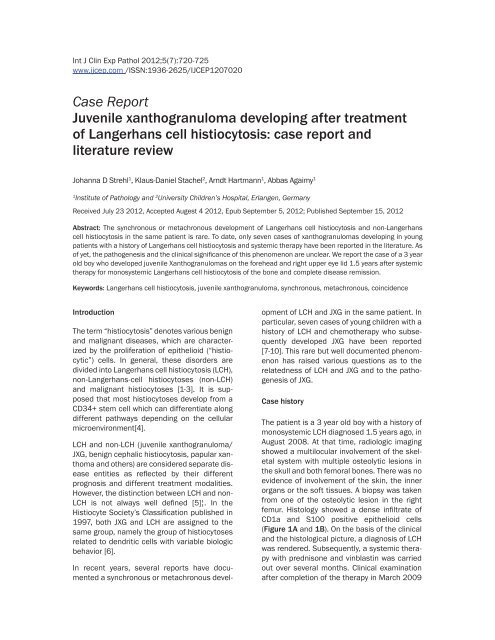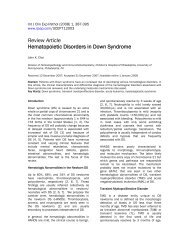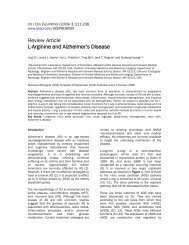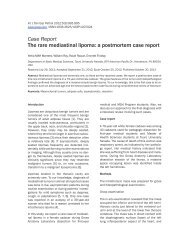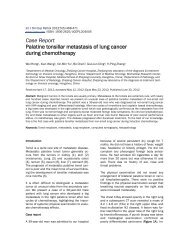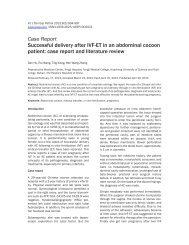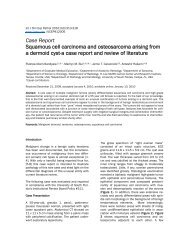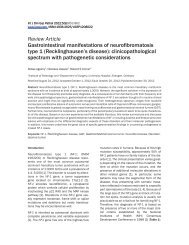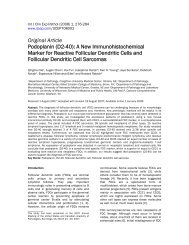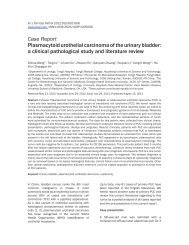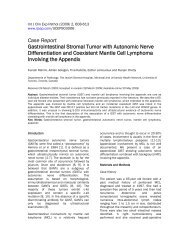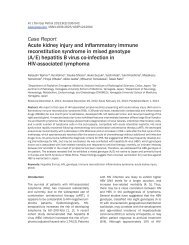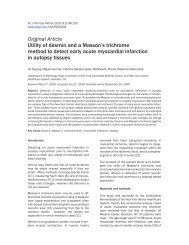Case Report Juvenile xanthogranuloma developing after treatment ...
Case Report Juvenile xanthogranuloma developing after treatment ...
Case Report Juvenile xanthogranuloma developing after treatment ...
You also want an ePaper? Increase the reach of your titles
YUMPU automatically turns print PDFs into web optimized ePapers that Google loves.
Int J Clin Exp Pathol 2012;5(7):720-725<br />
www.ijcep.com /ISSN:1936-2625/IJCEP1207020<br />
<strong>Case</strong> <strong>Report</strong><br />
<strong>Juvenile</strong> <strong>xanthogranuloma</strong> <strong>developing</strong> <strong>after</strong> <strong>treatment</strong><br />
of Langerhans cell histiocytosis: case report and<br />
literature review<br />
Johanna D Strehl 1 , Klaus-Daniel Stachel 2 , Arndt Hartmann 1 , Abbas Agaimy 1<br />
1<br />
Institute of Pathology and 2 University Children’s Hospital, Erlangen, Germany<br />
Received July 23 2012, Accepted Augest 4 2012, Epub September 5, 2012; Published September 15, 2012<br />
Abstract: The synchronous or metachronous development of Langerhans cell histiocytosis and non-Langerhans<br />
cell histiocytosis in the same patient is rare. To date, only seven cases of <strong>xanthogranuloma</strong>s <strong>developing</strong> in young<br />
patients with a history of Langerhans cell histiocytosis and systemic therapy have been reported in the literature. As<br />
of yet, the pathogenesis and the clinical significance of this phenomenon are unclear. We report the case of a 3 year<br />
old boy who developed juvenile Xanthogranulomas on the forehead and right upper eye lid 1.5 years <strong>after</strong> systemic<br />
therapy for monosystemic Langerhans cell histiocytosis of the bone and complete disease remission.<br />
Keywords: Langerhans cell histiocytosis, juvenile <strong>xanthogranuloma</strong>, synchronous, metachronous, coincidence<br />
Introduction<br />
The term “histiocytosis” denotes various benign<br />
and malignant diseases, which are characterized<br />
by the proliferation of epithelioid (“histiocytic”)<br />
cells. In general, these disorders are<br />
divided into Langerhans cell histiocytosis (LCH),<br />
non-Langerhans-cell histiocytoses (non-LCH)<br />
and malignant histiocytoses [1-3]. It is supposed<br />
that most histiocytoses develop from a<br />
CD34+ stem cell which can differentiate along<br />
different pathways depending on the cellular<br />
microenvironment[4].<br />
LCH and non-LCH (juvenile <strong>xanthogranuloma</strong>/<br />
JXG, benign cephalic histiocytosis, papular xanthoma<br />
and others) are considered separate disease<br />
entities as reflected by their different<br />
prognosis and different <strong>treatment</strong> modalities.<br />
However, the distinction between LCH and non-<br />
LCH is not always well defined [5]¦. In the<br />
Histiocyte Society’s Classification published in<br />
1997, both JXG and LCH are assigned to the<br />
same group, namely the group of histiocytoses<br />
related to dendritic cells with variable biologic<br />
behavior [6].<br />
In recent years, several reports have documented<br />
a synchronous or metachronous development<br />
of LCH and JXG in the same patient. In<br />
particular, seven cases of young children with a<br />
history of LCH and chemotherapy who subsequently<br />
developed JXG have been reported<br />
[7-10]. This rare but well documented phenomenon<br />
has raised various questions as to the<br />
relatedness of LCH and JXG and to the pathogenesis<br />
of JXG.<br />
<strong>Case</strong> history<br />
The patient is a 3 year old boy with a history of<br />
monosystemic LCH diagnosed 1.5 years ago, in<br />
August 2008. At that time, radiologic imaging<br />
showed a multilocular involvement of the skeletal<br />
system with multiple osteolytic lesions in<br />
the skull and both femoral bones. There was no<br />
evidence of involvement of the skin, the inner<br />
organs or the soft tissues. A biopsy was taken<br />
from one of the osteolytic lesion in the right<br />
femur. Histology showed a dense infiltrate of<br />
CD1a and S100 positive epithelioid cells<br />
(Figure 1A and 1B). On the basis of the clinical<br />
and the histological picture, a diagnosis of LCH<br />
was rendered. Subsequently, a systemic therapy<br />
with prednisone and vinblastin was carried<br />
out over several months. Clinical examination<br />
<strong>after</strong> completion of the therapy in March 2009
<strong>Juvenile</strong> <strong>xanthogranuloma</strong> <strong>after</strong> LCH<br />
Figure 1. Biopsy taken from the osteolytic lesion of the right femur. A. Polymorphous infiltrate of LCH cells and eosinophils.<br />
Some of the LCH cells display the characteristic reniform, grooved nuclei (Hematoxylin-Eosin, x400). B.<br />
CD1a immunohistochemistry showed a strong membranous positivity (x400).<br />
showed complete remission. 1.5 years <strong>after</strong><br />
the termination of therapy, the mother of the<br />
boy noticed growing lesions on the right-sided<br />
forehead and on the right upper eyelid. Clinical<br />
examination showed a subcutaneous, nonmovable,<br />
firm nodule of 2 cm on the right-sided<br />
forehead. There were no signs of inflammation.<br />
The overlying skin was normal. On the right<br />
upper eyelid an “appendage” of 0.3 cm was<br />
detected. This lesion was clinically interpreted<br />
as molluscum contagiosum. Both lesions were<br />
surgically excised.<br />
Histological findings<br />
Histologically both lesions displayed a solid<br />
tumefactive infiltrate, made up of mononuclear<br />
cells, which in part showed a xanthomatous<br />
morphology (Figure 2A and 2B). In some areas<br />
a spindle cell morphology with storiform growth<br />
pattern could be demonstrated. Scattered multinucleated<br />
giant cells with a Touton-like morphology<br />
were observed (Figure 2C). The nodules<br />
were sharply delineated against the<br />
surrounding tissue. The tumor cells stained<br />
positive for CD68 (Figure 2D), but were negative<br />
for protein S100, CD1a (Figure 2E) and<br />
CD207 (Langerin). There was a patchy positivity<br />
for Factor XIIIa. Due to the histomorphological<br />
picture and the immunohistochemical results,<br />
a diagnosis of JXG was made. 2 years <strong>after</strong> the<br />
resection of the lesions the patient is doing<br />
well, with no evidence of recurrent LCH or JXG.<br />
Discussion<br />
LCH and JXG show a clinical as well as a histopathological<br />
overlap, especially in children [11]<br />
(Table 1). Both LCH and JXG follow a chronic<br />
course and have a predilection for the skin, but<br />
both diseases may also present with systemic<br />
involvement of the internal organs, soft tissues<br />
and bone. Although most affected patients are<br />
children and young adults, the disorders may<br />
occur at virtually any age. Spontaneous regression<br />
is possible in both diseases, but it occurs<br />
significantly more often in JXG [7].<br />
The etiology of both LCH and JXG is still unclear.<br />
Specifically regarding LCH, the question whether<br />
the LCH lesions are neoplastic or reactive in<br />
nature is still a matter of controversy. Numerous<br />
characteristics of LCH, like the clonality of all<br />
non-pulmonary LCHs, recurrent genetic abnormalities<br />
of LCH cells and even, in rare cases,<br />
familial clustering of LCH are points in favour of<br />
the neoplastic theory. On the other hand, the<br />
benign cytology of LCH cells, the indolent clinical<br />
course of most LCH cases as well as the<br />
lack of clonality in pulmonary LCH may be considered<br />
arguments for a reactive nature of LCH<br />
[12]. These observations point to a heterogeneous<br />
etiology of LCH. In contrast, JXG is generally<br />
considered a reactive lesion derived from<br />
the monocyte/macrophage line [3, 13, 14].<br />
The metachronous development of JXG in<br />
patients with a history of LCH and chemothera-<br />
721 Int J Clin Exp Pathol 2012;5(7):720-725
<strong>Juvenile</strong> <strong>xanthogranuloma</strong> <strong>after</strong> LCH<br />
Figure 2. Subcutaneous tumor on the right-sided<br />
forehead. A. Polymorphous infiltrate of xanthomatous<br />
mononuclear cells and spindle cells typical of<br />
<strong>xanthogranuloma</strong> (Hematoxylin-Eosin, x200). B.<br />
higher magnification of a (x400). C. Touton giant<br />
cells seen at higher magnification with characteristic<br />
central wreath of nuclei and peripheral rim of xanthomatous<br />
cytoplasm (Hematoxylin-Eosin, x600). D.<br />
CD68 immunohistochemistry revealed cytoplasmic<br />
positivity in mononuclear and spindle cells. E. CD1a<br />
was negative in the <strong>xanthogranuloma</strong> cells (x400).<br />
py is a relatively rare phenomenon, which has<br />
evoked many questions regarding the pathogenesis<br />
and biology of LCH and non-LCH and<br />
their interrelationship. Up to now, 7 children<br />
and neonates who developed JXG following LCH<br />
and systemic therapy have been reported in<br />
four previous studies (Table 2). The time span<br />
between the diagnosis of LCH and the occurrence<br />
of JXG ranged from months to years. JXG<br />
arose either in anatomic sites previously<br />
involved by the LCH or at new sites previously<br />
unaffected by the LCH. All of the JXG were limited<br />
to the skin [7-10].<br />
In addition, two cases of synchronous JXG and<br />
LCH have also been reported. Shani-Adir et al<br />
described a two year old boy who presented<br />
with both benign cutaneous histiocytosis (a<br />
subcategory of JXG) and LCH with multilocular<br />
bone involvement [5]. Yu et al. reported the<br />
case of a several weeks old baby with a mixed<br />
histiocytosis of the skin with hybrid features of<br />
722 Int J Clin Exp Pathol 2012;5(7):720-725
<strong>Juvenile</strong> <strong>xanthogranuloma</strong> <strong>after</strong> LCH<br />
Table 1. Histomorphological, immunohistochemical and ultrastructural characteristics of LCH and JXG<br />
Langerhans cell Histiocytosis<br />
<strong>Juvenile</strong> Xanthogranuloma<br />
Main lesional cell(s) LCH cell. Varying amounts of mononuclear<br />
cells, multinucleated cells with or<br />
without Touton features and spindle<br />
cells.<br />
Accompanying inflammatory infiltrate<br />
Cytology of main lesional cell(s)<br />
Touton cells<br />
Pronounced.<br />
Made up of eosinophils, neutrophils,<br />
histiocytes, lymphocytes and plasma<br />
cells. The eosinophilic infiltrate may<br />
be very prominent, even dominating<br />
the histologic presentation.<br />
LCH cells often have an elongated,<br />
reniform, vesicular nucleus which<br />
sometimes shows a groove parallel<br />
to its long axis (“nuclear fold”).<br />
Touton-like multinucleated giant<br />
cells can be demonstrated in rare<br />
instances and do not preclude the<br />
diagnosis of LCH!<br />
Mostly sparse.<br />
Lesions may contain scattered eosinophils,<br />
lymphocytes and plasma<br />
cells. However, „younger“ lesions<br />
can present with a prominent eosinophilic<br />
infiltrate even reminiscent<br />
of LCH.<br />
Immunohistochemistry<br />
CD1a:+<br />
S100:+<br />
CD207(Langerin):+<br />
CD68:variable, usually negative<br />
Factor XIIIa: variable, usually negative<br />
Electron microscopy of main lesional Birbeck granules<br />
cell(s)<br />
Mononuclear cells display a<br />
rounded to elongated, sometimes<br />
reniform nucleus.<br />
Mononuclear and multinucleated<br />
cells may contain fine cytoplasmic<br />
vacuoles leading to a xanthomatous<br />
appearance.<br />
Classic Touton cells with a central<br />
wreath of nuclei and a peripheral<br />
rim of eosinophilic to vacuolated<br />
cytoplasm can be demonstrated in<br />
most of the cases. Absence of Touton<br />
cells however does not preclude<br />
diagnosis of JXG<br />
CD1a:-<br />
S100:-<br />
CD207(Langerin):-<br />
CD68:+<br />
Factor XIIIa: variable, usually positive<br />
No Birbeck granules<br />
Table 2. <strong>Report</strong>ed cases of JXG following LCH and systemic therapy.<br />
No Author/<br />
reference<br />
Sex/Age at diagnosis<br />
of LCH<br />
Localization LCH Localization JXG Time span<br />
between LCH<br />
and JXG<br />
1 Hoeger et al. Male, 17 months Scalp, skin, pituitary Eye lids, axilla 5 years<br />
gland<br />
2 Hoeger et al. Female, 2 years skin Eye lids, throat 2.5 years<br />
3 Hoeger et al. Female, 11 months Skin, bone, pituitary<br />
gland<br />
4 Patrizi et al. Female, 15 months Skin, bones, lymph<br />
nodes<br />
Eye lids, throat,<br />
thighs<br />
Trunk, thighs,<br />
perianal<br />
3 years<br />
3.5 months<br />
5 Patrizi et al. Male, 14 months Skin, bone Trunk, extremities 1.5 years<br />
6 Perez-Gala et al. Female, 2.5 months Skin, bone, liver, eye Cheek 9.5 months<br />
7 Bains et al. Male, neonate Skin External auditory 2 years<br />
canal<br />
8 Current case Male, 3 years Bone Eye lid, Forehead 1.5 years<br />
723 Int J Clin Exp Pathol 2012;5(7):720-725
<strong>Juvenile</strong> <strong>xanthogranuloma</strong> <strong>after</strong> LCH<br />
JXG and LCH [4]. Furthermore, Tran et al<br />
described the case of a young woman with a<br />
history of JXG at the age of 20. She did not<br />
receive any systemic therapy. Three years later<br />
the patient developed diabetes insipidus as<br />
well as a pelvic mass lesion. A biopsy of the pelvic<br />
mass yielded a diagnosis of LCH [15].<br />
These rare examples of JXG preceding, concomitant<br />
to or following a diagnosis of LCH<br />
underscore the close relationship between<br />
these clinically and biologically distinct disorders.<br />
On an experimental basis, studies have<br />
shown that the cells of LCH and JXG are derived<br />
from the same cell line, namely a colony forming<br />
type of dendritic cells/monocytes [16].<br />
In-vitro experiments have demonstrated that<br />
variations in the local cytokine environment<br />
may activate macrophages and modulate their<br />
phenotype [3]. Even changes in lineage differentiation<br />
could be observed. On the basis of<br />
these observations, Patrizi et al hypothesized<br />
that JXG appearing subsequent to LCH may represent<br />
a further conversion or, rather, a form of<br />
“maturation” of the LCH cells under the influence<br />
of chemotherapy [7, 8]. However, the theory<br />
of a differentiation switch from LCH cell to<br />
JXG cell under chemotherapy remains purely<br />
speculative up to now.<br />
Another theory regarding the occurrence of JXG<br />
in patients with LCH is based on the assumption<br />
that JXG may be triggered either by the LCH<br />
lesions themselves or by the effects of chemotherapy.<br />
Several disease entities have been<br />
described which seem to be able to promote or<br />
trigger the development of non-LCHs e.g. atopic<br />
dermatitis [17] and childhood leukemia [13].<br />
These clinical observations have given rise to<br />
the hypothesis that JXG may be triggered or<br />
modulated by cytokines [3]. It is well known<br />
that LCH lesions produce abundant amounts of<br />
different cytokines, a phenomenon referred to<br />
as “cytokine storm” [18]. Chemotherapy itself<br />
is also liable to cause changes in the cytokine<br />
microenvironment. However, the current literature<br />
yields no conclusive data as to which specific<br />
cytokine or molecule might be responsible<br />
for the development of JXG.<br />
In conclusion, we described a further case of<br />
JXG following treated LCH in a child and<br />
reviewed the literature on this topic. This rare<br />
occurrence underlines the relationship and<br />
overlap between LCH and non-LCH. However,<br />
the significance of the synchronous or metachronous<br />
occurrence of JXG in patients with<br />
LCH remains still poorly understood. Two interesting<br />
theories exist which are aimed at explaining<br />
this phenomenon, but both lack scientific<br />
validation, especially on an in vivo level. Further<br />
studies are needed to further elucidate the etiology<br />
and interrelationship of LCH and JXG.<br />
Acknowledgements<br />
The authors would like to thank Ivor Leuschner,<br />
MD, Kiel, Germany, for performing the Langerin<br />
stain.<br />
Address correspondence to: Dr. Abbas Agaimy,<br />
Pathologisches Institut, Krankenhausstrasse 8-10,<br />
91054 Erlangen, Germany Phone: +49-(0) 9131 85<br />
22288 Fax: +49-(0) 9131 85 24745 E-mail: abbas.<br />
agaimy@uk-erlangen.de<br />
References<br />
[1] Histiocytosis syndromes in children. Writing<br />
Group of the Histiocyte Society. Lancet 1987;<br />
1: 208-209.<br />
[2] Gianotti F and Caputo R. Histiocytic syndromes:<br />
a review. J Am Acad Dermatol 1985; 13: 383-<br />
404.<br />
[3] Zelger BW, Sidoroff A, Orchard G and Cerio R.<br />
Non-Langerhans cell histiocytoses. A new unifying<br />
concept. Am J Dermatopathol 1996; 18:<br />
490-504.<br />
[4] Yu H, Kong J, Gu Y, Ling B, Xi Z and Yao Z. A<br />
child with coexistent juvenile <strong>xanthogranuloma</strong><br />
and Langerhans cell histiocytosis. J Am<br />
Acad Dermatol 2010; 62: 329-332.<br />
[5] Shani-Adir A, Chou P, Morgan E and Mancini<br />
AJ. A child with both Langerhans and non-<br />
Langerhans cell histiocytosis. Pediatr Dermatol<br />
2002; 19: 419-422.<br />
[6] Favara BE, Feller AC, Pauli M, Jaffe ES, Weiss<br />
LM, Arico M, Bucsky P, Egeler RM, Elinder G,<br />
Gadner H, Gresik M, Henter JI, Imashuku S,<br />
Janka-Schaub G, Jaffe R, Ladisch S, Nezelof C<br />
and Pritchard J. Contemporary classification of<br />
histiocytic disorders. The WHO Committee On<br />
Histiocytic/Reticulum Cell Proliferations. Reclassification<br />
Working Group of the Histiocyte<br />
Society. Med Pediatr Oncol 1997; 29: 157-<br />
166.<br />
[7] Hoeger PH, Diaz C, Malone M, Pritchard J and<br />
Harper JI. <strong>Juvenile</strong> <strong>xanthogranuloma</strong> as a sequel<br />
to Langerhans cell histiocytosis: a report<br />
of three cases. Clin Exp Dermatol 2001; 26:<br />
391-394.<br />
[8] Patrizi A, Neri I, Bianchi F, Guerrini V, Misciali C,<br />
Paone G and Burnelli R. Langerhans cell histio-<br />
724 Int J Clin Exp Pathol 2012;5(7):720-725
<strong>Juvenile</strong> <strong>xanthogranuloma</strong> <strong>after</strong> LCH<br />
cytosis and juvenile <strong>xanthogranuloma</strong>. Two<br />
case reports. Dermatology 2004; 209: 57-61.<br />
[9] Perez-Gala S, Torrelo A, Colmenero I, Contra T,<br />
Madero L and Zambrano A. [<strong>Juvenile</strong> multiple<br />
<strong>xanthogranuloma</strong> in a patient with Langerhans<br />
cell histiocytosis]. Actas Dermosifiliogr 2006;<br />
97: 594-598.<br />
[10] Bains A and Parham DM. Langerhans cell histiocytosis<br />
preceding the development of juvenile<br />
<strong>xanthogranuloma</strong>: a case and review of<br />
recent developments. Pediatr Dev Pathol<br />
2011; 14: 480-484.<br />
[11] Dehner LP. <strong>Juvenile</strong> <strong>xanthogranuloma</strong>s in the<br />
first two decades of life: a clinicopathologic<br />
study of 174 cases with cutaneous and extracutaneous<br />
manifestations. Am J Surg Pathol<br />
2003; 27: 579-593.<br />
[12] Egeler RM, van Halteren AG, Hogendoorn PC,<br />
Laman JD and Leenen PJ. Langerhans cell histiocytosis:<br />
fascinating dynamics of the dendritic<br />
cell-macrophage lineage. Immunol Rev<br />
2010; 234: 213-232.<br />
[13] Hernandez-Martin A, Baselga E, Drolet BA and<br />
Esterly NB. <strong>Juvenile</strong> <strong>xanthogranuloma</strong>. J Am<br />
Acad Dermatol 1997; 36: 355-367; quiz 368-<br />
359.<br />
[14] Sangueza OP, Salmon JK, White CR Jr and<br />
Beckstead JH. <strong>Juvenile</strong> <strong>xanthogranuloma</strong>: a<br />
clinical, histopathologic and immunohistochemical<br />
study. J Cutan Pathol 1995; 22: 327-<br />
335.<br />
[15] Tran DT, Wolgamot GM, Olerud J, Hurst S and<br />
Argenyi Z. An ‘eruptive’ variant of juvenile <strong>xanthogranuloma</strong><br />
associated with langerhans cell<br />
histiocytosis. J Cutan Pathol 2008; 35 Suppl 1:<br />
50-54.<br />
[16] Arceci RJ. The histiocytoses: the fall of the Tower<br />
of Babel. Eur J Cancer 1999; 35: 747-767;<br />
discussion 767-749.<br />
[17] Goerdt S, Kretzschmar L, Bonsmann G, Luger<br />
T and Kolde G. Normolipemic papular xanthomatosis<br />
in erythrodermic atopic dermatitis. J<br />
Am Acad Dermatol 1995; 32: 326-333.<br />
[18] Egeler RM, Favara BE, van Meurs M, Laman JD<br />
and Claassen E. Differential In situ cytokine<br />
profiles of Langerhans-like cells and T cells in<br />
Langerhans cell histiocytosis: abundant expression<br />
of cytokines relevant to disease and<br />
<strong>treatment</strong>. Blood 1999; 94: 4195-4201.<br />
725 Int J Clin Exp Pathol 2012;5(7):720-725


